 |
| Cleopatra would drool |
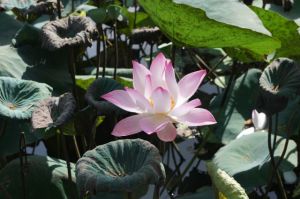 |
| Lotus in full bloom |
Today had to be a softer day. Saturday was just that. We headed for the Mekong Delta to spend some boating time and see how coconuts and rice are part of daily life and industry.
Like an elephant among ants, we squeezed through the morning motorcycle rush and escaped on a good 6 lane highway aiming to put ourselves in the watery web of the Mekong River. This River, life-giving and huge, ranking with the Amazon, the Nile, and of course our own Mississippi, has nine branches called “nine dragons” or “Cuu Long” with riverlets, channels, and canals hidden among water palms of all sort covering the narrow canals and irrigation rows like arcades.
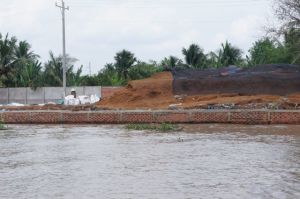 |
| Coconut powder for orchids |
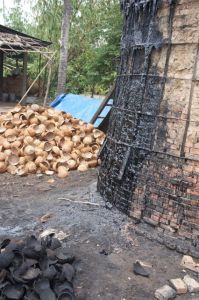 |
| Coconuts for charcoal |
As I’m sure you know by now, if there was an elephant in the province, I’d smell him and have arranged a ride. But sadly, poaching has reduced the 2000 Asian elephants acknowledged in 1975 after the war to about 100 today. There was a time in the 15th century when the King rode an elephant calvary to victory over the Ming horse calvary and gain independence from China. Now most of the land where elephants and tigers once roamed is farmed – coffee, pepper, tobacco, rice, rubber trees, cashew trees – and forests, as we know, have been destroyed (either cut down or Agent Orange destruction). Now elephants, tigers and rhinos are protected because tigers are coveted for medicine and high prices paid for their parts (shocking) so only a handful remain. The only reference to elephant I’ve heard in Vietnam is when we were served “elephant ear fish”, unique to the Mekong Delta. It must be eaten immediately have being fished out of the waters and fried whole. It is not exported; exportation of fish is huge, mostly tilapia, tuna and snapper.
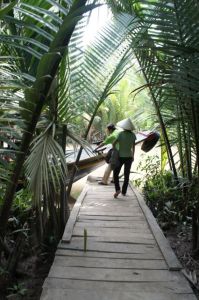 |
| To the boat |
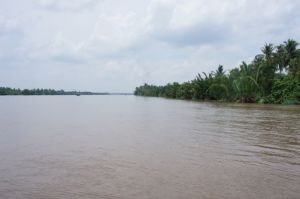 |
| Mekong River |
Our destination today was south to Ben Tre province, famous for coconut production and multitude of waterways. We first stopped at a “tourist stop” for a glass of iced Vietnamese coffee (strong to curl the toes) to which sweeten condensed milk and safe crushed ice is added. I swooned for a minute as I thought I was back at Starbucks. Even the plastic glass had a green label. But this is COFFEE and you have to like how it packs a punch. Coffee and tea are both farmed in Vietnam. In the park area there was a pond teeming with lotus flowers in various stage of opening. They always take your breath away. I remember varieties of them in Chiang Mai, Thailand last year.
After about two hours, we arrived at a small shack encased in tropical jungle wildness. I was given a Vietnamese pyramidal bamboo hat, secured under my chin, and we transferred to the popular “cyclo” or “xe loi”, farm version – like riding in the metal back of a pickup truck. Bumpy. The motorcycle that pulls the “cyclo” coughs and sputters as we wind through small paths covered in every kind of palm frond, bamboo and banana leaf on the way to a Huu Dinh village, wherever that is. The driver had only a few teeth but knew where we were supposed to be. He dropped us off in a shady place where cold towels, fresh fruit and tea awaited to refresh us.
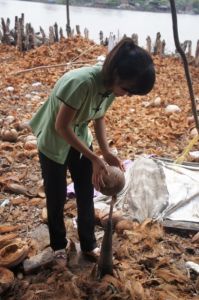 |
| Stabbing the coconut |
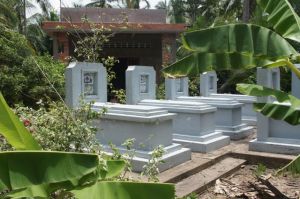 |
| front yard tombstones |
I was curious about large concrete boxes painted white, red or even salmon colors – such a size a horse could be buried in. I was told, they are permanent coffins planted in the front or back yard of small homes and farms. Apparently, this is where the original owner of the farm is buried so by law no one claim the land and the children (really the son) will take possession without tax or fury. Often there are 3 or four of these well placed coffins to be seen, so no one will make a mistake who owns the land. This is seen on rice plantations, as well, small altars and tombs of owners to stabilize the family’s claim to the land. I’m told families were only allowed two children. This may have changed.
 |
| Making rice noodles |
 |
| Sampan down the canal |
After 15 minutes battling with my Vietnamese bamboo hat (which makes everything sound weird) and one more cold wet towel (these are life savers in the heat) we arrived at the edge of the Mekong River where a beautiful long boat awaited us – decked out like something a modern Cleopatra might enjoy – even with two long deck chairs to take a nap in, if needed. A basket of unusual tropical fruit awaited us, along with the proverbial wet towels and bottles of cold water. Everywhere we are offered these things, but never the Duran fruit which is famous for its atrocious odor. Here the mangosteen is the queen of fruits. And cumquats are steamed with palm sugar and honey for those who have lost their voices. Singers don’t drink the cumquat juice but if they eat the rind, voices will soar. Well, that’s what they tell me.
I was one happy camper because next to the elephant, put me on water and I can deep breathe, meditate and do needlepoint (bears). The Mekong, though brown like the Mississippi, teems with boats and fishing life. Shrimp traps. Fish traps. Water hyacinths – famous during the war because Viet Cong hid beneath them as they crossed the river underwater. And all along the edges are coconut factories, red brick factories and rice noodle plants. There is a breeze, which dries us a bit from the continual sweat. We pull in at a coconut plant to see its many uses. Coconut hulls make unbreakable bowls and are excellent sources of charcoal – they are burned til black and are good carbon filtering sources. Coconut fiber is used in textiles. Coconut water is the latest craze and is exported and it is used to make caramel candy in Vietnam. Coconut meat inside has various edible forms (if you can get it out, I can’t) and is used in curry powder. But the most interesting is the unusable husk parts are turned into powder and this is the best fertilizer for orchids and bonsai.
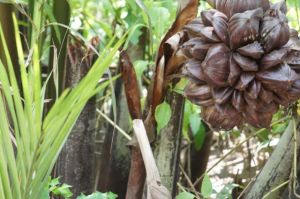 |
| Water palm fruit |
We followed this with a visit to a mom and pop Hu Tieu rice noodle factory. It’s fascinating to watch how they soak the rice in water til it softens almost into a pulp, then drain it and squeeze it through a roller (primitive) to make a flat thin rectangle sheet about a 5 by 2 foot that looks like cellophane. Fragile, it is laid on a bamboo tray about the same size and placed out in the sun to dry. Then it is put through another roller with fine niches for the fettucini-sized rice noodle. It’s the pasta of this part of the world. We were supposed to meet with a Viet Cong veteran who, with his wife, makes rice paper, but this day was a national holiday and many had gone to town to celebrate.
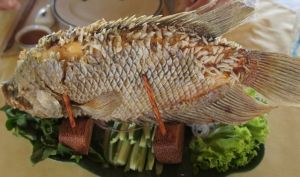 |
| Fried fresh Elephant ear Fish |
Somehow, waiting at the end of a dusty path, was a small doubtful boat called a sampan. It’s a wooden canoe where you can see the water coming up through the shallow floor, and it has to be paddled through canals covered in palm fronds, water palm flowers and fruits. It was hot and in the canal area, no cooling breeze. Sitting on a wooden plank was hard on the butt. But we were taken back to our long boat for a ride across the river to a resort where we had a five course lunch. And here, folks, delight among delight, I learned how to make my own spring roles from various veggies, basel leaf, coriander, pineapple and elephant ear fish fried and de-scaled right before us. Now this is something I could do. Wrapping flat rice noodles pancakes around the conglomeration was a breeze since I’ve been making sushi rolls for 30 years, when desperate. These “banh uot cuon” or fresh spring rolls (as opposed to fried ones) are dipped in peanut sauce. Sigh.
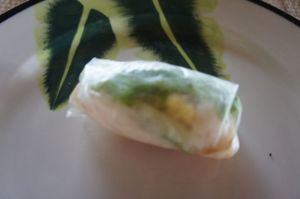 |
| Audrey’s spring roll |
It was a good day, far from the images and propaganda of wars never forgotten. CNN promised the Boston Marathon Bomber had been captured. I was at peace as my feet were massaged and I watched a light show off the Marriott Hotel tall walls while sitting in a comfy chair in a windowed spa biting into a French macaroon and sipping a tiny cup of jasmine tea. Believe it!














Audrey,
Sounds like your Sunday on the Mekong River was a little less hectic than most of the days you have experienced in that primitive part of the world. One might even think you had a quiet, peaceful day.
We can only imagine you on the long boat fitting for Cleopatra. If the boat was good enough for her, it is definitely a conveyance you deserve. We have a beautiful visual image of you in the long boat on the Mekong River surrounded by lotus blossoms and water hyacinths.
Obviously, the Mekong River and the coconut plant play very important roles in the daily lives of the Vietnamese. It is interesting that these people have found so many different uses for the cocnut plant. It is a poor country and no doubt they have to be as resourceful as possible.
We would enjoy your spring roll and the rice noodles, but not so sure we want to have a go at the Elephant Ear Fish. It may be too exotic for us.
Today is Monday and the Grizzlies have their second playoff game tonight. Hopefully, they can come back after losing so badly last Saturday.
You have been gone for a long time. Difficult to believe that you still have almost three weeks left before you return home. We miss you.
Love you,
Geraldean and Judge
Oops!
We left the “o” out of coconut the second time we used that word.
Sorry!